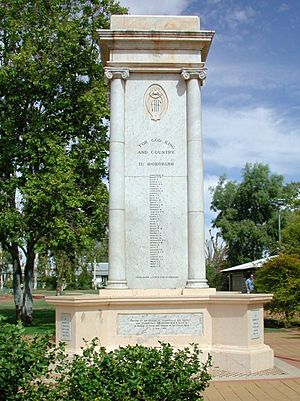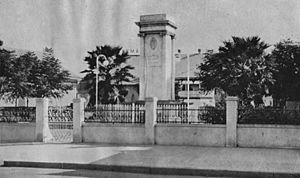Charleville War Memorial facts for kids
Quick facts for kids Charleville War Memorial |
|
|---|---|

Charleville War Memorial, 2005
|
|
| Location | Edward Street, Charleville, Shire of Murweh, Queensland, Australia |
| Design period | 1919–1930s (interwar period) |
| Built | 1924 |
| Architect | George Brockwell Gill |
| Official name: Charleville War Memorial | |
| Type | state heritage (built) |
| Designated | 21 October 1992 |
| Reference no. | 600758 |
| Significant period | 1924- (social) |
| Significant components | park / green space, pathway/walkway, gate — entrance, war trophy/ies, memorial/monument, fence/wall — perimeter, memorial surrounds/railings, flagpole/flagstaff |
| Builders | R C Ziegler and Son |
| Lua error in Module:Location_map at line 420: attempt to index field 'wikibase' (a nil value). | |
The Charleville War Memorial is a special monument in Charleville, Australia. It is listed on the Queensland Heritage Register. This means it's an important historical place. It was designed by George Brockwell Gill and built in 1924 by R C Ziegler and Son. The memorial helps us remember the brave people from the area who served in wars.
Contents
Remembering Our Heroes
Why War Memorials Are Important
The Charleville War Memorial was officially opened on 9 October 1924. The Queensland Governor, Sir Matthew Nathan, was there. It cost about £1000 (around $1,800 in today's money). This beautiful memorial is mostly made of marble. It honors 310 local men from Charleville who served in the First World War. This includes 40 who sadly lost their lives.
The memorial was built by the people of Charleville and the local Returned Services League. A strong cast-iron fence was added later, between 1925 and 1933.
Australia and World War I
Before World War I, Australia didn't have many public monuments. But after the war, memorials became very important. They were the first national monuments. They showed how much the war affected our young country. Australia lost 60,000 people from a population of about 4 million. This was one in five of all who served. No other war has had such a big impact on Australia.
Even before the war ended, people started building memorials. They were a way to show sadness and respect. For many, these memorials were like graves. They were for Australians whose bodies were buried far away in battlefields. The word "cenotaph" means "empty tomb." It was often used for war memorials.
Australian war memorials are special because they don't just remember those who died. They also honor everyone who served. Australians were proud that their first big army was made of volunteers. These men were honored whether they died or came home. Many memorials list all who served from a town. This helps us understand how much communities were involved in the war.
The People Behind the Memorial
The Charleville memorial is thought to be designed by George Brockwell Gill. He was an architect from Ipswich. His design is similar to the Esk War Memorial, which Gill also designed.
George Brockwell Gill was born in England. He moved to Australia in 1886. He became a well-known architect. He designed many important buildings in Ipswich. He was also the president of the Queensland Institute of Architects in 1918.
The memorial was built in Toowoomba by a company called R C Ziegler and Son. They were famous for their stone work. They made many memorials across Queensland. The company later moved to Bundaberg.
What the Memorial Looks Like
The First World War Memorial is in a park in Charleville. The park has a fancy fence and gates. A path leads right to the memorial. Inside the park, you can also see two old guns (war trophies) and a flagpole.
The memorial itself has a cast iron fence around it. This fence has pointed tops shaped like a fleur-de-lis. There's a gate in the middle of the fence.
The monument is made of Italian marble and stands about 7 meters (23 feet) tall. It sits on a base made of terrazzo. The top of this base has light and dark tiles in a chequerboard (checkerboard) pattern. Above this is a sandstone base. This base is square and has plaques on all sides. These plaques remember later wars, and even the Boer War.
In the center of the base is a square pillar. It has columns at each corner. This pillar is also made of Italian marble. It has the names of those who served in World War I written in lead. The front panel is for those who died. At the top of each side, there are carved shields with the letters AIF. This stands for the Australian Imperial Forces. The columns have special tops (capitals) and bottoms (bases). They hold up a decorative top part called a cornice and a frieze.
Why This Place is Special
The Charleville War Memorial was added to the Queensland Heritage Register on 21 October 1992. This means it's officially recognized as an important historical site.
A Piece of Queensland's Story
War Memorials show how Queensland's history has changed. They are found in most towns. They show how much people felt proud of Australia, especially during and after World War I.
What Makes It Unique
This memorial is a great example of a monument built to remember a big historical event. It uses special materials and design. It was built in 1924 and is a lasting record of the past.
Beautiful Design
The memorial is also important because it's very well made and designed. Monuments like this are rare in Queensland. The only other one known to be similar is in Esk.
Important to the Community
This memorial represents both the town and the area around it. It's very important to the community. It reminds them of the impact of a major historical event. It's also a central place for people to remember those who served.
Connected to Important People
The memorial is also special because it's linked to the architect George Brockwell Gill. It's also an example of the work of the stone masonry company R Ziegler and Sons.


